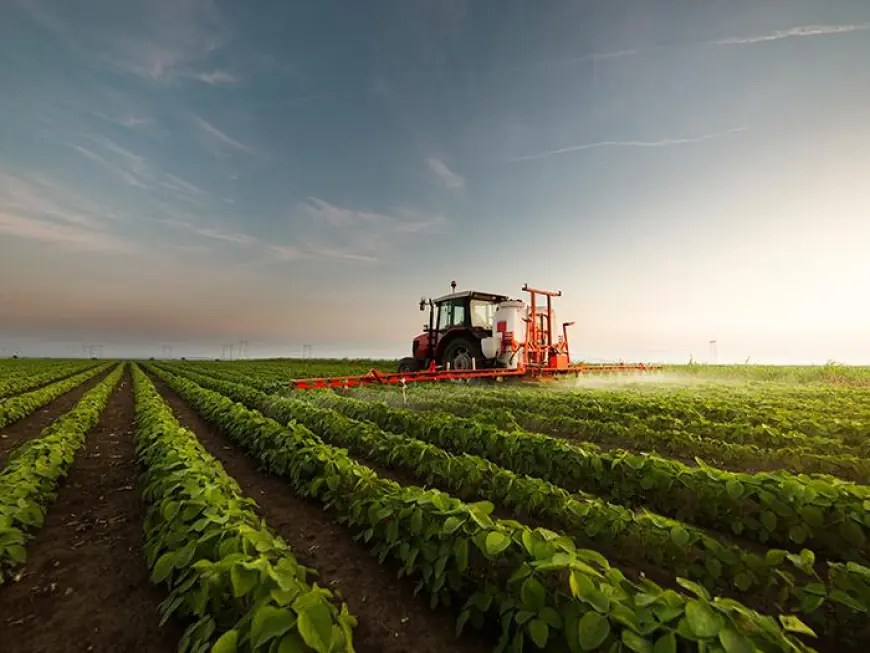Crop Reinsurance Market 2030 Forecast: Drivers and Challenges
Governments and international organizations also play a role in promoting the adoption of crop reinsurance to enhance food security and support sustainable agricultural practices.

Introduction
The global agricultural sector stands as one of the most vital pillars supporting human survival, and within it, risk management mechanisms such as crop reinsurance play a critical role. Agriculture is inherently exposed to an array of unpredictable risks — from erratic weather patterns and pest infestations to volatile commodity prices. Crop reinsurance provides a safety net, ensuring that both farmers and insurers can withstand financial shocks and recover swiftly after adverse events.
According to industry estimates, the Global Crop Reinsurance Market was valued at USD 38.40 billion in 2023 and is projected to expand at a CAGR of 6.56% between 2025 and 2029. This growth trajectory underscores the rising need for robust agricultural risk mitigation tools amid escalating climate uncertainties, shifting market dynamics, and increasing food demand.
The Role of Crop Reinsurance in Agricultural Stability
Crop reinsurance functions as an additional layer of security for primary insurers, enabling them to share and transfer the risks associated with large-scale agricultural losses. By redistributing exposure to global reinsurance markets, insurers can provide farmers with more comprehensive coverage and stable premiums. This mechanism fosters resilience not only for individual farmers but also for national and global food supply chains.
Key benefits of crop reinsurance include:
- Financial stability for insurers and farmers.
- Enhanced capacity to absorb catastrophic losses.
- Encouragement of agricultural investment due to reduced risk exposure.
- Protection of rural economies reliant on farming incomes.
Download Free Sample Report: https://www.techsciresearch.com/sample-report.aspx?cid=23482
Market Drivers
1. Climate Change and Increasing Risk Exposure
One of the most prominent forces shaping the market is the growing volatility of climate conditions. Unpredictable rainfall, prolonged droughts, and more frequent storms have significantly heightened the financial risks faced by the agricultural sector. Crop reinsurance becomes essential to safeguard against the increasing frequency and intensity of weather-related losses.
2. Technological Advancements in Risk Assessment
The adoption of precision agriculture, satellite monitoring, and AI-driven data analytics has transformed how insurers evaluate and price agricultural risks. Parametric insurance, triggered by predefined thresholds such as rainfall levels or temperature deviations, allows for faster payouts and reduced administrative costs.
3. Global Agricultural Expansion
Rising population numbers are driving the need for increased food production, leading to expansion into new agricultural territories. These regions often present unfamiliar climatic challenges, further increasing the demand for comprehensive reinsurance solutions.
4. Government Initiatives and Subsidies
Several governments and international agencies are supporting crop insurance and reinsurance programs to stabilize rural economies and safeguard food security. Subsidized premiums and public-private partnerships are boosting market penetration.
Emerging Trends in the Crop Reinsurance Market
1. Rise of Parametric and Index-Based Insurance
Instead of indemnifying based on actual losses, parametric policies pay out when predefined triggers occur — for example, rainfall below a certain threshold. This trend is reshaping the reinsurance landscape by delivering faster claims processing and greater transparency.
2. Sustainability-Driven Insurance Products
With the growing focus on sustainable agriculture, reinsurers are designing policies tailored for organic farming, conservation agriculture, and regenerative farming practices. These specialized products address unique risks, such as lower yields during soil recovery phases or pest challenges in chemical-free farming.
3. Collaboration with AgriTech Firms
Partnerships between reinsurers and technology companies are improving data collection, risk modeling, and claims verification. Use of IoT sensors, drone surveillance, and real-time weather data is enabling more precise risk assessment.
4. Digital Distribution Channels
The rise of online platforms and mobile-based insurance services is making crop reinsurance more accessible, particularly in developing markets where physical access to insurers is limited.
Industry Key Highlights
- Market Value (2023): USD 38.40 billion
- Forecast CAGR (2025-2029): 6.56%
- Primary Growth Drivers: Climate change, tech innovation, government support, global food demand.
- High-Growth Segment: Crop Price Reinsurance, driven by volatile commodity prices.
- Top Emerging Trend: Sustainability-linked crop insurance products.
- Data Dependency: Success of reinsurance models hinges on accurate, real-time agricultural data.
- Technological Influence: AI, IoT, and satellite imaging redefining risk modeling.
- Key Restraint: Affordability challenges for smallholder farmers.
Market Segmentation Overview
By Type
- Crop Yield Reinsurance – Protects against yield drops caused by adverse weather or pests.
- Crop Price Reinsurance – Mitigates risks from commodity price volatility; gaining significant traction globally.
- Crop Revenue Reinsurance – Combines yield and price coverage for comprehensive protection.
By Application
- Multi-Peril Crop Insurance (MPCI) – Covers multiple risks including drought, flood, pests.
- Crop Hail – Protects against hail damage.
- Livestock and Forestry – Extending beyond crops to other agricultural assets.
By Distribution Channel
- Insurance Companies – Primary issuers of crop policies.
- Agents & Brokers – Facilitate market reach and farmer engagement.
- Others – Including online and cooperative channels.
Competitive Analysis
The global crop reinsurance market is moderately consolidated, with major players leveraging technology, global reach, and strong capital reserves to maintain dominance. Key strategies include mergers, acquisitions, partnerships with AgriTech firms, and product diversification.
Major Market Players
- Munich Re Group – A leader in innovative risk modeling and parametric insurance solutions.
- Swiss Reinsurance Company Ltd – Known for its strong presence in emerging markets and sustainability initiatives.
- Tokio Marine Holdings Inc. – Expanding through strategic acquisitions in agriculture-heavy regions.
- Chubb Group of Insurance Companies – Offers a wide portfolio, including weather index insurance.
- Zurich Insurance Group Ltd – Strong focus on public-private partnerships.
- Sompo Holdings Inc. – Pioneering digital transformation in claims processing.
- Hannover Re Group – Specialized in multi-peril crop insurance programs.
- Allianz SE – Leading provider of global agricultural reinsurance coverage.
- Aon PLC – Strong consulting arm supporting data-driven insurance modeling.
- National Crop Insurance Services – Key player in the U.S. crop insurance ecosystem.
Future Outlook
The next five years are expected to be transformative for the global crop reinsurance market. Climate change will continue to be a double-edged sword — creating both heightened risks and increased demand for reinsurance solutions. The integration of AI, blockchain, and remote sensing technologies will enhance underwriting accuracy, claims transparency, and operational efficiency.
Key predictions include:
- Wider adoption of parametric policies to accelerate payouts.
- Greater integration of sustainability metrics in insurance underwriting.
- Expansion in emerging markets, especially in Asia-Pacific and Africa.
- Improved affordability through microinsurance models and government subsidies.
10 Benefits of the Research Report
- Comprehensive Market Overview – Detailed coverage of market size, growth rate, and forecasts.
- In-Depth Segmentation Analysis – Insights into types, applications, and distribution channels.
- Emerging Trend Identification – Tracks innovations like parametric insurance and sustainability-linked policies.
- Competitive Intelligence – Profiles of leading companies and their strategies.
- Growth Driver Insights – Analysis of climate change impact, technology adoption, and policy support.
- Risk and Challenge Assessment – Identifies market barriers and potential solutions.
- Regional Market Insights – Evaluation of key markets across continents.
- Future Market Forecasting – Data-driven predictions for 2025–2029.
- Investment Decision Support – Helps stakeholders identify high-potential segments.
- Customizable Data – Flexibility for tailored business intelligence needs.
Conclusion
The Global Crop Reinsurance Market is at the intersection of agriculture, finance, and technology. As climate risks intensify and food demand rises, the importance of robust reinsurance mechanisms cannot be overstated. Technological advancements, sustainability considerations, and supportive government policies are redefining how risks are assessed and managed. While challenges such as data gaps and affordability for smallholder farmers remain, the market's adaptability ensures its continued relevance in safeguarding global food security.
Contact Us-
Mr. Ken Mathews
708 Third Avenue,
Manhattan, NY,
New York – 10017
Tel: +1-646-360-1656
Email: [email protected]
Website: www.techsciresearch.com
What's Your Reaction?
 Like
0
Like
0
 Dislike
0
Dislike
0
 Love
0
Love
0
 Funny
0
Funny
0
 Angry
0
Angry
0
 Sad
0
Sad
0
 Wow
0
Wow
0


















































